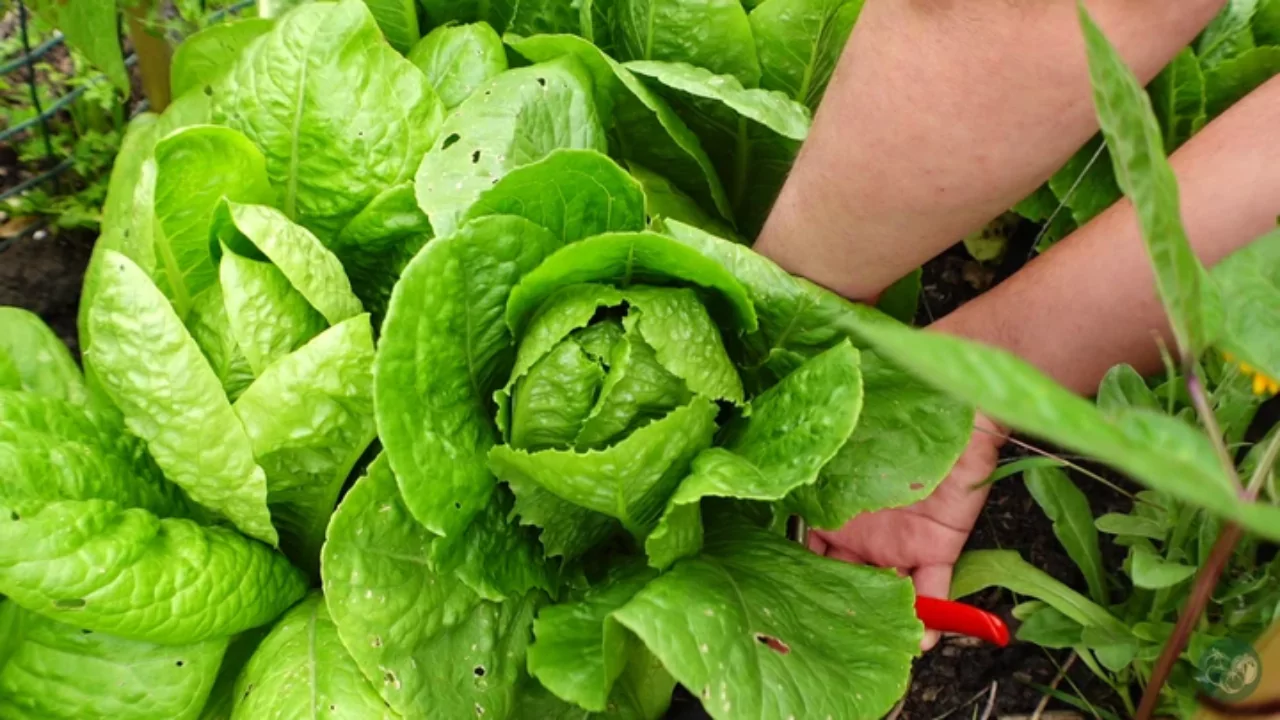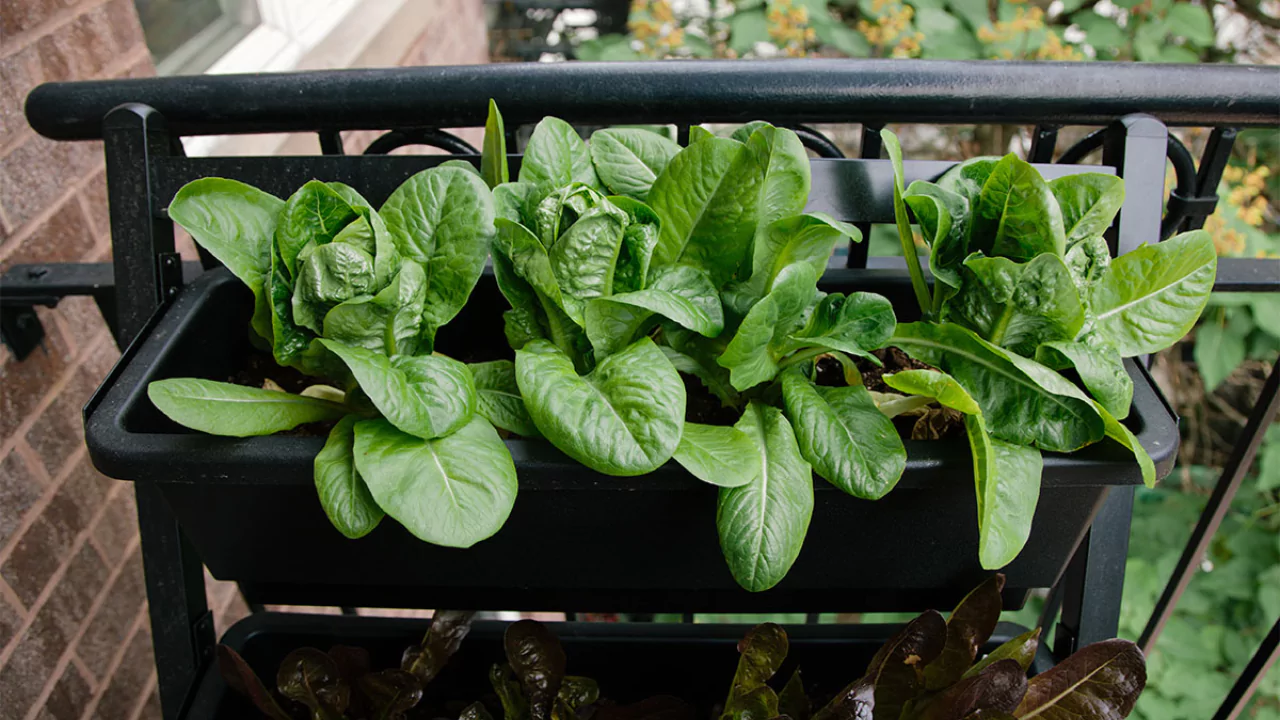
Romaine lettuce, also known as ‘cos’ lettuce is a type of lettuce that many people enjoy. Unlike most lettuces, Romaine heads are tall and made up of sturdy leaves. The name Romaine came from the Romans who brought the lettuce to them from most likely either Greece or Arabia.
Like all vegetables and leafy greens, romaine has a wide variety of nutritional benefits. An important benefit includes antioxidants alongside trace minerals and fiber.
Here’s how to enjoy the many benefits of growing romaine at home.
Growing Condition for Romaine Lettuce
Does Romaine Lettuce Need Full Sun?
Romaine is relatively more heat-tolerant than other varieties of lettuce. Some even deemed ‘Sparx’, ‘Coastal Star,’ and ‘Jericho’ to be some of the most heat resistant varieties.
While these types do tolerate heat well, even moisture rich soil tends to favor cooler climates.
Most variations of leaf and head lettuces are prone to bolting due to too much exposure under high sun temperatures.
“Bolting is the phenomenon occurring in certain vegetable crops when they irreversibly go to seed, generally rendering them unusable. A drop in temperature or a change in photoperiod can act as triggers for this condition. It can occur in many different vegetables such as lettuce and fennel.”
The tendency of Lettuce to flower apace with going to seed is an adaptive strategy for survival smoothly blended into its metabolism. In actual fact, you are growing lettuce for its leaves. During this phase the plant bolt’s metabolism reduces leave production and makes them bitter.
While Romaine is slowest to bolt, unseasonal hot weather spells will cause it to bolt too.
In general, there are a few precautions that easily eliminate bolting:
- Grow resistant varieties such as Romaine which includes ‘Sparx’, ‘Salvius’ and ‘Jericho’. These heat-resistant cultivars are less prone to bolting compared to other stems.
- Try using Mini-Romaines these soon mature (before heat sets in), thus were best at avoiding mid-season bolting.
- Position plants in partial shade – restricting sunlight on romaine plants positively benefits taste and foliage yields increasing leaf formation around stem leading to fuller heads of robust and flavorful greens.
- Transplanting Your Leaf Lettuce. Many gardeners take the more direct route, which is to lift and re-transplant their crops. This often results in plant shock which stops bolting.
How Long Does It Take to Grow Romaine Lettuce?
With proper attention, water, and good soil, romaine will grow faster than other varieties of lettuce. As mentioned before, helping guide the growth rate allows for a higher yield of crispy leaves. It also takes 65-70 days from seedling stage for romaine to fully mature.
Romaine expands characteristically with compact dark green leaves and can reach towering heights of twenty inches alongside squattier head-varieties of lettuce as well. Supplmental nutrition fosters rapid growth during early stages.
A notable characteristic about these plants is that there are several available variations in shape and color that could help you meet your timeframe goal. For instance, many have been bred to be ready within 30 days while others can be harvested as microgreens.
How to Plant Romaine Lettuce
These plants respond positively towards most garden types as long as there is ample sunlight however; growing seeds indoors is encouraged for stronger starts after being transplanted outside due to ease of planting afterwards.
You can plant them in:
- Outdoor garden plots.
- Pots or other vessels.
- Traditional and raised gardening beds.
- Vertical gardens, whether indoors or outdoors.
- In soil-free hydroponic systems.

- Growing Romaine lettuce vertically.
- Growing Romaine lettuce hydroponically
- Growing Romaine lettuce in the garden
However, if you prefer a more conventional approach, follow these guidelines for maximizing yields when planting Romaine lettuce:
- Sow seeds in early spring and late summer for maximum yield potential.
- To minimize bolting, start your spring crops with indoor seedlings.
- For fall crops, direct sow in late summer to the garden soil.
- For extended harvests plant Romaine every week or bi-weekly within the specified timeframe.
- Ensure optimal spacing by placing them 12-18 inches apart; more space generally encourages larger head size.
- Transplanting should occur during cooler evenings which reduces dehydration risk, ideally around early evening when temperatures are less stressful out of direct sunlight to mitigate shock.
Can You Regrow Romaine Lettuce?
There are multiple options to grow lettuces right at your home as different growing hacks comes handy sometime.
Did you ever consider reusing scraps from cooking? This method is applicable for regrowing Romaine lettuce stems by reusing leftover stems from previously used plants.
And here’s how:
To get the best results from this experiment, try to time your mini indoor harvest just right. If you choose to let your lettuce stem grow for a longer period, it will become spindly and develop a bitter taste.
In this case, buy some fresh produce from your local farm or fresh produce market as they are more likely to yield better results than the packaged grocery store lettuce.
Here are the steps to regrow your Romaine:
- Cut the lettuce stems roughly 1 inch from the bottom.
- Pour 1/2 inch of water into a dish and immerse the stems into the water.
- Position the dish near the source of natural light or under the grow light. Use regular light bulbs or LED lights.
- Don’t forget to change the water. Do it every one or two days.
- Your lettuce leaves and roots will start sprouting before long.
- You should have your lettuce all grown within the fortnight. Will your lettuce grow into a full head? Not really. One lettuce head planted will give you enough ingredients for a small salad bowl serving.
- Harvest your lettuce when it takes on a blue-green color and the center leaves get less dense.
Care Of Romaine Lettuce
Once established, romaine plants thrive best in cool weather paired with ample moisture.
They have to be guarded against the various pests that can attack them.
What Is the Best Way to Grow Romaine Lettuce?
Growing lettuce is simple and so is romaine. However, if you live in areas of extreme temperature fluctuations or persistent high winds, take extra measures.
Here’s the best way to grow lettuce in your garden:
- To guard against late-spring chills and early-summer heat, use floating row covers. Another option would be to plant the lettuce next to taller companions like shrubs or screening plants.
- To make the most out of your fall crops before lower temperatures set in, time maturity properly in order to prevent frost damage. Otherwise, the frost will severely diminish yields.
- Regular fertilization is a must as romaine and all lettuces require this for sustained leaf production. When picking a fertilizer, go for one with closely matching hyphenated numbers on its label.
- In summer months , plant bolt resistant varieties that are more resistant to bolting.
- During drought periods, irrigation should happen every 4-5 days.
How Do You Prepare Your Soil?
Romaine lettuce grows optimally in loamy soil with good drainage. It must also retain some moisture. Therefore, the soil needs to be kept moist but not too wet.
Similar to other salad greens, Romaine thrives in soils with neutral pH levels between 6.0 to 6.5.
Target soils should be treated a few weeks prior the spring planting date so that the nutrients can fuse properly into the soil.
Here’s how to prepare your ground bed for next season of Romaine:
- Mulch your soil to keep moisture levels in check.
- If you grow your Romaine in sandy or clay soil add compost to improve soil quality. Add 2 to 4 inches of compost to the soil, working it in 6 inches deep.
- Treat the soil with lime to keep it more alkaline.
- Fertilizing can be helpful to promote faster growth. Add a fish emulsion fertilizer to your soil. It will promote germination and prevent Romaine from tasting bitter.
- Apply nitrogen, phosphorus, and potassium fertilizer blend before planting your lettuce. An addition of 16-16-8 fertilizer will work best.
To optimize plant growth, apply an extra dose of 21-0-0 nitrogen fertilizer four weeks post planting at the rate of ¼ cup per each 10-foot row of lettuce.
Romaine Lettuce Pests and Diseases
Which Are Some of the Pests and Diseases to Look Out For?
To begin with, shaping up your Romaine needs pest control. Many unwanted visitors in the form of pests threaten the crisp and sweet taste of Romaine which is loved by many people.
Shot hole disease can cause immense havoc to your Romaine garden plants. This fungus makes the outer leaves develop soggy tan spots which become tan and eventually fall off.
How Do You Deal With Pests and Diseases?
Most problems can be solved by natural methods such as soap or diatomaceous earth.
In whatever way you decide to manage the harm done to Romaine crops in your garden try not to use pesticides. Using natural repellents is much more effective than pesticides because bueno if applied they will result in contamination.
Here’s how to address the most common problems with Romaine:
- Using floating row covers, rabbit resistant chicken wire, or elevated containers for growing will keep rabbits out effectively.
- Protect your Romaine against slugs using slug traps or diatomaceous earth.
- To keep aphids away, ensure proper soil drainage or physically remove them with a hose.
- To mitigate shot hole disease, prune infected stems and rotate crops.
Harvesting Romaine Lettuce
Romaine is ready for harvest once it reaches an adequate size. Many home gardeners prefer to remove the outer leaves and let the inner portion continue growing to prolong the harvest period.
Preemptively harvest prior to the first frost or cold weather sets in.
This can be done in one of two ways:
- Complete extraction from the ground and pulling it out completely,
- Creating a head by cutting it at ground level.
As for backyard gardeners, I recommend fully removing the plant from the garden bed; otherwise, stubborn roots will result in a mess of tangled heads through disorganized regrowth.